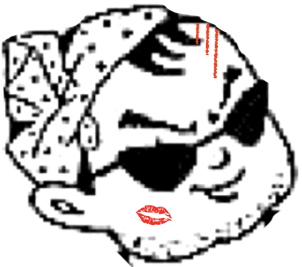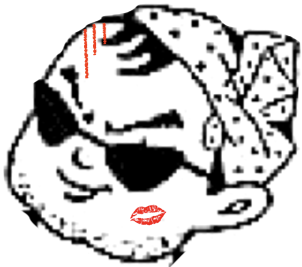signified and signifier
池田光穂
シニフィアンとシニフィエ
signified and signifier
池田光穂
記号論において、シニフィエとシニフィアン(フランス語: signifiéとsignifiant)は記号を構成する2つの主要な要素であり、シニフィエは記号が表すもの、あるいは参照するもので、「内容の平 面」として知られ、シニフィエは「表現の平面」、つまり記号自体の観察可能な側面である。この考え方は、記号論の二人の創始者の一人であるスイスの言語学 者フェルディナン・ド・ソシュールの研究で初めて提唱された。
★「記号の世界」より
「記号があるところには(フェルディナンド・ド・ソシュール[Ferdinand de
Saussure, 1857-1913]という言語学者によると)、記号作 用部=意味するもの(シニフィアン,
significant(Eng), signifian)と、記号意味部=意味されるもの(シニフィエ, signified(Eng.),
signifie')、の2つの要素がみつかる。
日本語で「犬(いぬ)」という「意味するもの」があるが、これを聞いた日本語を理解する人
は、「ワンワン吠えたり、尻尾をふったり、よだれをたらしたりする動物」のことを理解する。この後者が「意味される」ものである。
英語ではDog(スペイン語ではperro, perra
[前者は雄犬])であることを現在では誰もが知っていることであるが、犬と呼んだり、dogと呼んだりすることは、その固有の言語の規則であって、犬とい
う名詞に「意味されるもの」を結びつける必然性というものはない。
これは、当たり前のように思えるが、それは我々がソシュールらが構築した常識の世界を生きて
いるからで、言語のもつ規約性(人は言語による約束に従うことを通して意味を交換することができること)を指摘した重要な発見であると言われている。」
| In semiotics, signified
and signifier
(French: signifié and signifiant) are the two main components of a
sign, where signified is what the sign represents or refers to, known
as the "plane of content", and signifier which is the "plane of
expression" or the observable aspects of the sign itself. The idea was
first proposed in the work of Swiss linguist Ferdinand de Saussure, one
of the two founders of semiotics. |
記号論において、シニフィエとシニフィアン(フランス語:
signifiéとsignifiant)は記号を構成する2つの主要な要素であり、シニフィエは記号が表すもの、あるいは参照するもので、「内容の平
面」として知られ、シニフィエは「表現の平面」、つまり記号自体の観察可能な側面である。この考え方は、記号論の二人の創始者の一人であるスイスの言語学
者フェルディナン・ド・ソシュールの研究で初めて提唱された。 |
| Concept of signs The concept of signs has been around for a long time, having been studied by many classic philosophers such as Plato, Aristotle, Augustine, William of Ockham, and Francis Bacon, among others.[1] The term semiotics derives from the Greek root seme, as in semeiotikos (an 'interpreter of signs').[2]: 4 It was not until the early part of the 20th century, however, that Saussure and American philosopher Charles Sanders Peirce brought the term into more common use.[3] While both Saussure and Peirce contributed greatly to the concept of signs, it is important to note that each differed in their approach to the study. It was Saussure who created the terms signifier and signified in order to break down what a sign was. He diverged from the previous studies on language as he focused on the present in relation to the act of communication, rather than the history and development of words and language over time.[3] Succeeding these founders were numerous philosophers and linguists who defined themselves as semioticians. These semioticians have each brought their own concerns to the study of signs. Umberto Eco (1976), a distinguished Italian semiotician, came to the conclusion that "if signs can be used to tell the truth, they can also be used to lie."[2]: 14 Postmodernist social theorist Jean Baudrillard spoke of hyperreality, referring to a copy becoming more real than reality, the signifier becoming more important than the signified.[4] French semiotician Roland Barthes used signs to explain the concept of connotation—cultural meanings attached to words—and denotation—literal or explicit meanings of words.[2] Without Saussure's breakdown of signs into signified and signifier, however, these semioticians would not have had anything to base their concepts on. |
サインの概念 記号の概念は古くから存在しており、プラトン、アリストテレス、アウグスティヌス、オッカムのウィリアム、フランシス・ベーコンなど、多くの古典的な哲学 者によって研究されてきた[1]: 4 しかし、ソシュールとアメリカの哲学者チャールズ・サンダース・パースがこの用語をより一般的に使用するようになったのは20世紀初頭のことであった [3]。 ソシュールとパースはともに記号の概念に大きく貢献したが、それぞれ研究に対するアプローチが異なっていたことに注意することが重要である。記号が何であ るかを分解するためにシニフィアンとシニフィエという用語を生み出したのはソシュールである。彼は言葉や言語の歴史や発展よりも、コミュニケーション行為 に関連する現在に焦点を当てたことで、それまでの言語研究とは一線を画していた[3]。 これらの創始者の後を継いだのは、自らを記号学者と定義する数多くの哲学者や言語学者たちであった。これらの記号学者たちは、それぞれ記号の研究に独自の 関心を持っている。イタリアの著名な記号学者であるウンベルト・エーコ(1976年)は、「記号が真実を語るために使われることがあるならば、嘘をつくた めにも使われることがある」という結論に達した[2]: 14 ポストモダニズムの社会理論家であるジャン・ボードリヤールは、コピーが現実よりもリアルになること、シニフィエがシニフィエよりも重要になることを指す ハイパーリアリティについて語った[4]。フランスの記号学者であるロラン・バルトは、コノテーション(言葉に付けられた文化的意味)とデノテーション (言葉の文字通りの意味または明示的意味)の概念を説明するためにサインを使用した[2]。 |
| Relation between signifier and
signified Saussure, in his 1916 Course in General Linguistics, divides the sign into two distinct components: the signifier ('sound-image') and the signified ('concept').[2]: 2 For Saussure, the signified and signifier are purely psychological: they are form rather than substance.[5]: 22 Today, following Louis Hjelmslev, the signifier is interpreted as the conceptual material form, i.e. something which can be seen, heard, touched, smelled or tasted; and the signified as the conceptual ideal form.[6]: 14 In other words, "contemporary commentators tend to describe the signifier as the form that the sign takes and the signified as the concept to which it refers."[7] The relationship between the signifier and signified is an arbitrary relationship: "there is no logical connection" between them.[2]: 9 This differs from a symbol, which is "never wholly arbitrary."[2]: 9 The idea that both the signifier and the signified are inseparable is explained by Saussure's diagram, which shows how both components coincide to create the sign. In order to understand how the signifier and signified relate to each other, one must be able to interpret signs. "The only reason that the signifier does entail the signified is because there is a conventional relationship at play."[8]: 4 That is, a sign can only be understood when the relationship between the two components that make up the sign are agreed upon. Saussure argued that the meaning of a sign "depends on its relation to other words within the system;" for example, to understand an individual word such as "tree," one must also understand the word "bush" and how the two relate to each other.[7] It is this difference from other signs that allows the possibility of a speech community.[8]: 4 However, we need to remember that signifiers and their significance change all the time, becoming "dated." It is in this way that we are all "practicing semioticians who pay a great deal of attention to signs … even though we may never have heard them before."[2]: 10 Moreover, while words are the most familiar form signs take, they stand for many things within life, such as advertisement, objects, body language, music, and so on. Therefore, the use of signs, and the two components that make up a sign, can be and are—whether consciously or not—applied to everyday life. |
シニフィアンとシニフィエの関係 ソシュールは1916年の『一般言語学講義』において、記号を2つの異なる構成要素、すなわちシニフィアン(「音像」)とシニフィエ(「概念」)に分けて いる[2]: 2 ソシュールにとって、シニフィエとシニフィエは純粋に心理的なものであり、それらは実体ではなく形式である[5]: 22。 今日、ルイ・ヘルムスレフに倣って、シニフィエは概念的な物質形態、すなわち見たり、聞いたり、触れたり、匂いを嗅いだり、味わったりすることができるも のとして解釈され、シニフィエは概念的な理想形態として解釈されている[6]: 14言い換えれば、「現代の論者たちは、シニフィエを記号がとる形式とし て、シニフィエを記号が参照する概念として記述する傾向がある」[7]: 「このことは、「決して完全に恣意的ではない」[2]: 9記号とは異なる。シニフィアンとシニフィエの両方が不可分であるという考えは、ソシュールの図によって説明される。 シニフィアンとシニフィエがどのように関係し合っているかを理解するためには、記号を解釈できなければならない。「シニフィエがシニフィエを内包する唯一 の理由は、従来の関係が作用しているからである」[8]: 4 つまり、記号を構成する2つの要素の関係が合意されて初めて、記号は理解できるのである。例えば、「木」のような個々の単語を理解するためには、「茂み」 という単語も理解しなければならず、その2つが互いにどのように関連しているのかを理解しなければならない[7]。 このような他の記号との違いが、音声共同体の可能性を可能にするのである[8]: 4 しかし、シニフィエとその意味は常に変化し、"時代遅れ "になっていくことを忘れてはならない。このように、私たちはみな「記号に多大な注意を払う実践的記号学者」なのである: 10 さらに、言葉はサインがとる最も身近な形ではあるが、広告はもちろん、物、ボディランゲージ、音楽など、生活の中のさまざまなものを表している。したがっ て、サインの使用と、サインを構成する2つの要素は、意識的かどうかにかかわらず、日常生活に応用することができ、また応用されている。 |
| Lacanianism Main article: Lacanianism Jacques Lacan presented formulas for the ideas of the signified and the signifier in his texts and seminars, specifically repurposing Freud's ideas to describe the roles that the signified and the signifier serve as follows: There is a 'barrier' of repression between Signifiers (the unconscious mind: 'discourse of the Other') and the signified […] a 'chain' of signifiers is analogous to the 'rings of a necklace that is a ring in another necklace made of rings' […] 'The signifier is that which represents a subject (fantasy-construct) for another signifier'.[9][10][11] — Lacan, paraphrased Floating signifier Main article: Floating signifier For broader coverage of this topic, see Name and Private language argument. See also: Parallax § As_a_metaphor Originating in an idea from Lévi-Strauss, the concept of floating signifiers, or empty signifiers, has since been repurposed in Lacanian theory as the concept of signifiers that are not linked to tangible things by any specific reference for them, and are "floating" or "empty" because of this separation. Slavoj Žižek defines this in The Sublime Object of Ideology as follows: [T]he multitude of 'floating signifiers' […] is structured into a unified field through the intervention of a certain 'nodal point' (Lacanian point de capiton) which 'quilts' them [to] […] the 'rigid designator', which totalizes an ideology by bringing to a halt the metonymic sliding of its signified […] it is a signifier without the signified'.[12] Signified Main articles: Essence, Set (mathematics), and Schema (Kant) See also: Aether (classical element), Fallacy of division, and Fallacy of composition For broader coverage of this topic, see Narrative, Schema (psychology), Bracketing (phenomenology), and Intuition. The signified is [an untranslatable, atmospheric irreducibility of the-chain-of-signifiers-abstracted]; the disclosed barrier (between the-chain-of-signifiers qua signified) is a metaphor-repression-transference journey through place.[20] Schizoanalysis Main article: Schizoanalysis In their theory of schizoanalysis, Gilles Deleuze and Félix Guattari made radical uses of the ideas of the signified and the signifier following Lacan. In A Thousand Plateaus, extending from their ideas of deterritorialization and reterritorialization, they developed the idea of "faciality" to refer to the interplay of signifiers in the process of subjectification and the production of subjectivity. The "face" in faciality is a system that "brings together a despotic wall of interconnected signifiers and passional black holes of subjective absorption".[21] Black holes, fixed on white walls which antagonized flows bounce off of, are the active destruction, or deterritorialization, of signs.[22] What makes the power exerted by the face of a subject possible is that, creating an intense initial confusion of meaning, it continues to signify through its persistent refusal to signify.[23] Significance is never without a white wall upon which it inscribes its signs and redundancies. Subjectification is never without a black hole in which it lodges its consciousness, passion, and redundancies. Since all semiotics are mixed and strata come at least in twos, it should come as no surprise that a very special mechanism is situated at their intersection. Oddly enough, it is a face: the white wall/black hole system. […] The gaze is but secondary in relation to the gazeless eyes, to the black hole of faciality. The mirror is but secondary in relation to the white wall of faciality.[24] What distinguishes this radical use and systemization of the signified and the signifier as interplaying in subjectivity from Lacan and Sartre as well as their philosophical predecessors in general is that, beyond a resolution with the oppressive forces of faciality and the dominance of the face, Deleuze and Guattari reproach the preservation of the face as a system of a tight regulation of signifiers and destruction of signs, declaring that "if human beings have a destiny, it is rather to escape the face, to dismantle the face and facializations".[25] |
ラカニズム 詳細は「ラカニズム」を参照 ジャック・ラカンは、彼のテキストやセミナーにおいて、記号化されたものおよび記号化するものの概念の公式を提示し、特にフロイトの考えを転用して、記号 化されたものおよび記号化するものが果たす役割を次のように説明した。 シニフィアン(無意識の心:『他者の言説』)とシニフィエの間には抑圧の「障壁」がある……シニフィアンの「連鎖」は、「リングでできたネックレスのリン グが、別のネックレスのリングでもある」ことに類似している……「シニフィアンとは、ある主体(空想の構築物)を別のシニフィアンに代弁するものである」 [9][10][11]。 —ラカン、意訳 浮遊シニフィアン 詳細は「浮遊シニフィアン」を参照 このトピックに関するより広範な内容については、「名前」および「プライベート言語論」を参照のこと。 関連項目:視差 § 隠喩としての レヴィ=ストロースの考えに由来する「浮遊シニフィアン」または「空のシニフィアン」という概念は、それ以降、ラカンの理論では、具体的な参照によって有 形のものに結び付けられておらず、この分離によって「浮遊」または「空虚」であるシニフィアンという概念として再解釈されている。 スラヴォイ・ジジェクは『イデオロギーの崇高対象』で次のように定義している。 「浮遊するシニフィアン」の多数は、……ある「結節点」(ラカンの「キャピトン」)の介入によって統一的な場に構造化される。この結節点は、それらを「キ ルト」のように包み込み、……「硬直した指示対象」へと導く。硬直した指示対象は、シニフィエの換喩的な滑走を停止させることによってイデオロギーを総体 化する。……それはシニフィエを欠いたシニフィアンである。[12] シニフィエ 主な記事:本質、集合(数学)、およびスキーマ(カント) 関連項目:エーテル(古典元素)、分割の誤謬、および合成の誤謬 このトピックに関するより広範な内容については、「ナラティブ」、「スキーマ(心理学)」、「括弧付け(現象学)」、「直観」を参照のこと。 シニフィエとは、[翻訳不可能な、抽象化されたシニフィアン連鎖の不可還元性]であり、開示された障壁(シニフィアン連鎖 qua シニフィエ間の障壁)は、場所を通過する隠喩の抑圧と転移の旅である。[20] シゾ分析 詳細は「シゾ分析」を参照 シゾ分析の理論において、ジル・ドゥルーズとフェリックス・ガタリはラカンに倣って、シニフィエとシニフィアンという概念を根本的に用いた。『千のプラ トー』において、脱領土化と再領土化の概念を発展させ、彼らは「顔性」という概念を展開し、主体化の過程におけるシニフィアンの相互作用と主観性の生産を 指し示した。フェイシャリティにおける「顔」とは、「相互に連結したシニフィアンという専制的な壁と、主観的吸収の情動的なブラックホールを結びつける」 システムである。[21] ブラックホールは、流れを遮る白い壁に固定され、流れがぶつかり跳ね返る。記号の能動的な破壊、あるいは脱領土化である。[22] 主体の顔が発揮する力を可能にしているのは、意味の激しい初期混乱を生み出し、意味することを拒否し続けることで意味し続けることである。[23] 意味は、その記号や冗長性を記す白い壁なしには存在し得ない。主観化は、その意識、情熱、冗長性を収容するブラックホールなしには存在し得ない。すべての 記号論は混ざり合い、層は少なくとも2つずつ存在するため、その交差点に特別なメカニズムが位置していることは驚くことではない。奇妙なことに、それは顔 である。白い壁/ブラックホールのシステム。視線は、視線のない目、顔性というブラックホールと比較すると二次的なものにすぎない。鏡は、顔性という白い 壁と比較すると二次的なものにすぎない。[24] ラカンやサルトル、そして彼らの哲学的前身者たち一般と比較して、主観の中で相互作用するシニフィエとシニフィアンをこのように徹底的に使用し体系化して いる点で際立っているのは、顔性という抑圧的な力や顔の優位性との和解を超えて、ドゥルーズとガタリが ドゥルーズとガタリは、記号の厳格な規制システムとしての顔の保存と記号の破壊を非難し、「もし人間に運命があるとするならば、それは顔から逃れること、 顔と顔化を解体することである」と宣言している。[25] |
| https://en.wikipedia.org/wiki/Signified_and_signifier |
リンク
文献
その他の情報
Do not paste, but [re]think this message for all undergraduate students!!!
Copyleft, CC, Mitzub'ixi Quq Chi'j, 1996-2099
☆
 ☆
☆